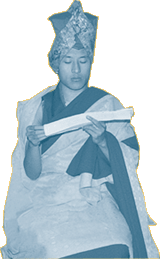| the Bodhi tree 2500 years ago. The West can analyze and criticize Tibetan culture, but I would be so thankful if they could have the humility and respect to leave the teachings of Siddhartha alone, or at least to study and practice them thoroughly before they set themselves up as authorities. | |
If people could put some effort into being respectful and open-minded, there is so much knowledge available that could liberate them from all kinds of suffering and confusion. It is only now that I have come to realize the significance of the great respect that the Tibetan translators and scholars of the past had toward India, their source of Dharma and wisdom. Instead of being critical or even resentful of their source, they called it "The Sublime Land of India". This kind of attitude is very different from the Western shopping mentality that regards the Dharma as merchandise and our own involvement as an investment-only wanting to accept what fits well with our habitual expectations and rejecting what we don't find immediately gratifying. |
 |
|
The difference lies in the attitude you take towards the criticism. In the process of analyzing that "yellow substance", the analyzer must not only maintain an open mind, but also acknowledge that he/she may not have an adequate knowledge of the subject matter. That is the whole point of analysis. Otherwise we are just seeking confirmation of what we already believe. Being skeptical and seeking faults are two completely different things. Nowhere is the difference between these two attitudes more obvious and more important than when it comes to criticisms of the Guru in Vajrayana Buddhism. Unfortunately, the Guru is a must for Vajrayana practice. However, all great masters and teachings repeatedly advise that one should always be skillful in checking the lama before one takes him as one's master. We have that option, and we should take advantage of it. It is vital to study the teachings extensively in order to be prepared to take on a teacher. In fact, some of the Vajrayana scriptures mention that one should check a potential eacher for twelve years before becoming his student. However, I think it is also important to remember that Buddhism is not only Vajrayana. There are other paths such as Theravada, which is the foundation of all Buddhist paths. This is a straightforward path, which does not spark off all kinds of mystical expectations. What sometimes seems to happen is that people want to practice Vajrayana because they see it as something exotic, when in fact they would be better off with the sanity and simplicity of the Theravada. In Vajrayana, in order to enable the Guru to help us and work on our dualistic ego-centered preoccupations, we are supposed to think that the Guru is no different in wisdom than the Buddha. This is the highest form of mind training. We are literally making a hero out of someone who, because he sees our potential, has no qualms about challenging and even abusing our narrow-minded and habitual patterns. This is a very radical, difficult and revolutionary method. From a conventional point of view, or from the point of view of ego-cherishing, the whole notion of the Guru-disciple relationship is something almost criminal. Yet the point to remember is that the only purpose of the existence of the Guru is to function as a skillful means to combat habits of dualistic conceptualizations, and to combat the tricks and tenacity of ego-clinging. In this way the Guru is a living manifestation of the teachings. It needs to be emphasized that it is our perception of the Guru which enables the Guru to function as a manifestation of the -- CONTINUE -- |
|
|
| Introduction
of Other Publications | Other
Buddhist Websites | Official
Publication | Colour
Photos |
| Activities Section
| Introduction of
Association | Items
for order | Forms
| Email Us | Home
|